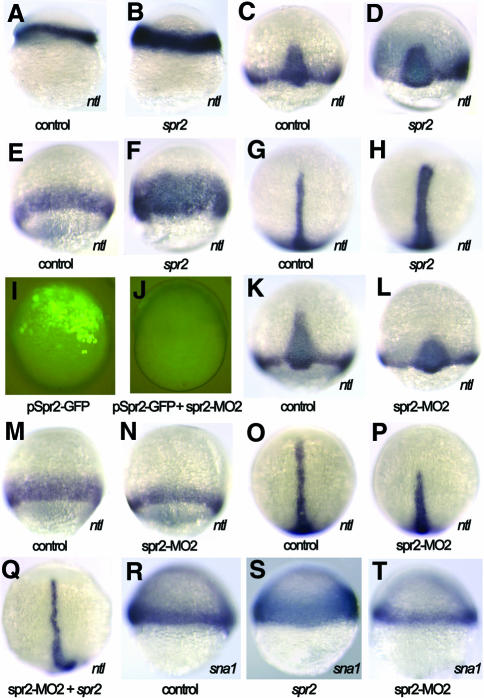Fig. 3. Spr2 positively regulates expression of ntl and sna1. (A, C, E, G, K, M, O and R) Control embryos injected with GFP mRNA or the control morpholino. (B, D, F, H–J, L, N, P, Q, S and T) Embryos injected with DNA (100 pg), mRNA (100 pg) and/or morpholino (5 ng) as indicated below each picture. (A and B) Lateral views at 40% epiboly, showing enhanced expression of ntl in the germ ring (B). (C and D) Dorsal views at 70% epiboly, showing ntl expansion in the axial mesoderm (D). (E and F) Ventral views at 70% epiboly, showing ntl expansion in the ventral germ ring (F). (G and H) Dorsal views at the bud stage, showing ntl expansion in the notochord (H). (I) Lateral view of a live embryo at 60% epiboly, showing green fluorescence expressed by pSpr2-GFP. (J) Co-injection with pSpr2-GFP DNA and spr2-MO2 inhibited Spr2-GFP expression. (K and L) Dorsal views at 75% epiboly. The spr2-MO2 injection caused loss of the anteriormost part of ntl expression domain in the axial mesoderm (L). (M and N) Ventral views at 75% epiboly, showing a thinner ntl expression domain in the germ ring (N). (O, P and Q) Dorsal views at the bud stage. The morpholino injection resulted in loss of the anterior notochord domain of ntl (P), which was rescued by co-injection with spr2 mRNA (Q). (R–T) Lateral views at 50% epiboly with dorsal to the right. Overexpression of spr2 expanded sna1 expression (S) while knocking down with spr2-MO2 led to fewer sna1-positive cells (T).

An official website of the United States government
Here's how you know
Official websites use .gov
A
.gov website belongs to an official
government organization in the United States.
Secure .gov websites use HTTPS
A lock (
) or https:// means you've safely
connected to the .gov website. Share sensitive
information only on official, secure websites.
